|
Occlusion-Capable
Volumetric 3D Display
O.
Cossairt,
J.
Napoli,
S.L.
Hill,
R.K.
Dorval,
G.E.
Favalora
|

|
Abstract
In April 2004 we built a 198-view multiview volumetric 3D display by
modifying the projection surface and rendering software of a
swept-screen Volumetric 3D Display (the Perspecta
Volumetric
Display shown above). An unmodified Perspecta
displays a volumetric 3D image by deconstructing a 3D model, such as a
computer tomography (CT) scan or molecular model, into a series of 768
pixel x 768 pixel slices. The projection surface is an omnidirectional
diffuser with nearly equal transmission and reflection coefficients.
Its 25 cm diameter disk-shaped active area is oriented with its normal
parallel to the floor and rotates at 900 rpm, centered on the axis of
rotation. A 6000 frame/sec DMD projector (Texas Instruments, Inc., Plano, Texas)
is used to project 396 slices per rotation that are perceived as a
superimposed volumetric 3D image. To ensure proper focus regardless of
screen angle, the screen is illuminated by a series of fold mirrors
that rotate with the screen.
To create an occlusion-capable 3D display, we replaced the projection
surface of a Perspecta display with a diffuser (Physical Optics Corporation, Torrance,
California) that has preferentially vertical diffusion and limited
horizontal diffusion advertised to be 60° x 0.1° (vertical x
horizontal). The vertical diffusion acts to broaden the exit pupil’s
vertical extent, providing a wide vertical viewing zone. The restricted
horizontal diffusion permits light to exit the display surface with
only minimally broadening, allowing the exit pupil to be swept
sequentially in the radial direction as the relay optics rotate. By
synchronizing projected images with the exit pupil position, we can
present a 3D image whose appearance varies with viewing direction over
the full 360° in the horizontal direction. To render imagery for
viewing on the 3D display, we render a sequence of images using a
virtual camera array placed along a circular track surrounding the
scene. In 2007, Researchers at USC built a similar 3D display based
on this concept, introducing improved rendering algorithms.
Publications
- O.
Cossairt,
J.
Napoli,
S.L.
Hill,
R.K.
Dorval,
G.E.
Favalora,
"Occlusion Capable
Volumetric Three-Dimensional Display". Applied
Optics, Mar. 2007, vol. 46, pp 1244-1250.
- O.
Cossairt, J. Napoli. "Radial
multiview
three-dimensional
displays". US Patent 7,277,226; Oct.
2007.
|
Images
Here we show images taken from different viewpoints for several 3D
scenes loaded onto the 3D the Occlusion-Capable Volumetric 3D display.
Each 3D scene was generated by rendering a computer model from a
sequence of perspectives, then loading the rendered images onto the 3D
display. The images shown are not renderings, they are photographs of
the 3D model loaded onto the 3D display. As the viewer changes
perspective, the appearance of the scene changes to give the impression
of being able to look around objects.
Snowman Scene
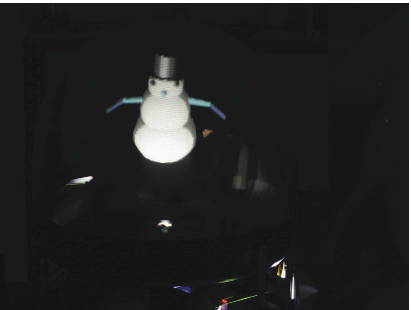 |
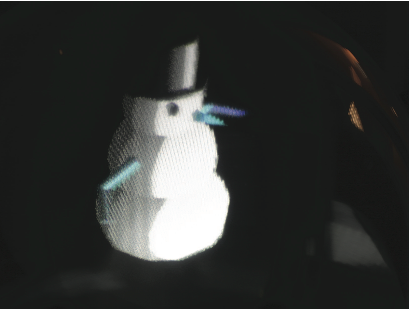
|
A
frontal
view
of a CG snowman.
|
A
side
view
of the snowman. Notice that the left arm and side of the face
is occluded by the body.
|
Perspecta Logo
 |
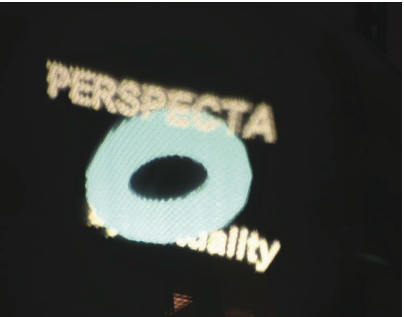
|
A
frontal
view
of a 3D logo. The text reads "Perspecta by Actuality".
Notice the lower text "by Actuality" is mostly occluded by the torus.
|
A
side
view
of the Perspecta Logo. Notice that the letters "al" are no
longer occluded while the letters "by" are now occluded.
|
Planets Scene
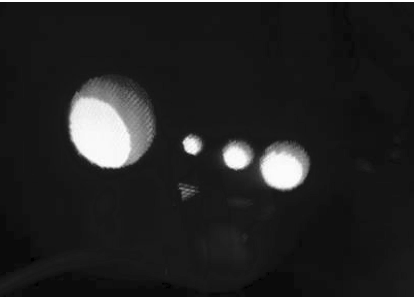 |
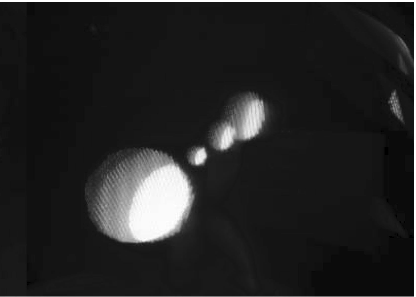
|
A
frontal
view
of a 3D model of four planets.
|
A
side
view
of the 3D planets scene. Notice that the furthest planet is
now occluded by the planet closer to the camera.
|
|
|
|






